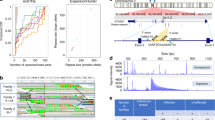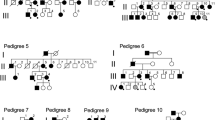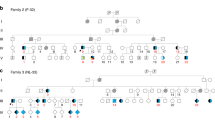Abstract
Progressive myoclonus epilepsy of Unverricht-Lundborg type (EPM1; MIM 254800) is an autosomal recessive disorder that occurs with a low frequency in many populations but is more common in Finland and the Mediterranean region1,2. It is characterized by stimulus-sensitive myoclonus and tonic-clonic seizures with onset at age 6–15 years, typical electroencephalographic abnormalities and a variable rate of progression between and within families3–5. Following the initial mapping of the EPM1 gene to chromosome 21 (ref. 6) and the refinement of the critical region to a small interval7–9, positional cloning identified the gene encoding cystatin B (C5T6), a cysteine protease inhibitor, as the gene underlying EPM1 (ref. 10). Levels of messenger RNA encoded by CST6 were dramatically decreased in patients. A 3′ splice site and a stop codon mutation were identified in three families, leaving most mutations uncharacterized10. In this study, we report a novel type of disease-causing mutation, an unstable 15- to 18-mer minisatellite repeat expansion in the putative promoter region of the CST6 gene. The mutation accounts for the majority of EPM1 patients worldwide. Haplotype data are compatible with a single ancestral founder mutation. The length of the repeat array differs between chromosomes and families, but changes in repeat number seem to be comparatively rare events.
This is a preview of subscription content, access via your institution
Access options
Subscribe to this journal
Receive 12 print issues and online access
$209.00 per year
only $17.42 per issue
Buy this article
- Purchase on Springer Link
- Instant access to full article PDF
Prices may be subject to local taxes which are calculated during checkout
Similar content being viewed by others
References
Berkovic, S.F., Berlovic, R., Carpenter, S. & Wolfe, L.S. Progressive myoclonus epilepsies: specific causes and diagnosis. N. Eng. J. Med. 315, 296–305 (1986).
Classification of progressive myoclonus epilepsies and related disorders. Ann. Neurol. 28, 113–116 (1990).
Koskiniemi, M., Donner, M., Majuri, H., Haltia, M. & Norio, R. Progressive myoclonus epilepsy: a clinical and histopathological study. Acta Neurol. Scand. 50, 307–322 (1974).
Norio, R. & Koskiniemi, M. Progressive myoclonus epilepsy: genetic and nosological aspects with special reference to 107 Finnish patients. Clin. Genet. 15, 382–398 (1979).
Koskiniemi, M., Toivakka, E. & Donner, M. Progressive myoclonus epilepsy. Electroencephalographical findings. Acta Neurol. Scand. 50, 333–359 (1974).
Lehesjoki, A.-E. et al. Localization of a gene for progressive myoclonus epilepsy to chromosome 21q22. Proc. Natl. Acad. Sci. USA 88, 3696–3699 (1991).
Lehesjoki, A.-E. et al. Linkage studies in progressive myoclonus epilepsy: Unverricht-Lundborg and Lafora's diseases. Neurology 42, 1545–1550 (1992).
Lehesjoki, A.-E. et al. Localization of the EPM1 gene for progressive myoclonus epilepsy on chromosome 21: linkage disequilibrium allows high resolution mapping. Hum. Mol. Genet. 2, 1229–1234 (1993).
Virtaneva, K. et al. Progressive myoclonus epilepsy EPM1 locus maps to a 175 kb interval in distal 21 q. Am. J. Hum. Genet 58, 1247–1253 (1996).
Pennacchio, L.A. et al. Mutations in the gene encoding cystatin B in progressive myoclonus epilepsy (EPM1). Science 271, 1731–1734 (1996).
Lehesjoki, A.-E. et al. PME of Unverricht-Lundborg type in the Mediterranean region: linkage and linkage disequilibrium confirm the assignment to the EPM1 locus. Hum. Genet. 93, 668–674 (1994).
Bell, G.I., Bell, M.J. & Rutter, W.J. The highly polymorphic region near the human insulin gene is composed of simple tandemly repeating sequences. Nature 295, 31–35 (1982).
Owerbach, D. & Gabbay, K.H. Localization of a type I diabetes susceptibility locus to the variable tandem repeat region flanking the insulin gene. Diabetes 42, 1708–1714 (1993).
Bell, G.I., Horita, S. & Karam, J.H. A polymorphic locus near the human insulin gene is associated with insulin-dependent diabetes mellitus.Diabetes 33, 176–183 (1984).
Bennet, S.T. et al. Susceptibility to human type 1 diabetes at IDDM2 is determined by tandem repeat variation at the insulin gene minisatellite locus. Nature Genet. 9, 284–292 (1995).
Kennedy, G.C., German, M.S. & Rutter, W.J. The minisatellite in the diabetes susceptibility locus IDDM2 regulates insulin transcription. Nature Genet. 9, 293–298 (1995).
Lucassen, A.M. et al. Regulation of insulin gene expression by the IDDM associated, insulin locus haplotype. Hum. Molec. Genet. 4, 501–506 (1995).
Gacy, A.M., Goellner, G., Juranic, N., Macura, S. & McMurray, C.T. Trinucleotide repeats that expand in human disease form hairpin structures in vitro. Cell 81, 533–540 (1995).
Chen, X. et al. Hairpins are formed by the single DNA strands of the fragile X triplet repeats: Structure and biological implications. Proc. Natl. Acad. Sci. 92, 5199–5203 (1995).
Ashley, C.T. Jr. & Warren, S.T. Trinucleotide expansions and human disease. Annu. Rev. Genet. 29, 703–728 (1995).
de la Chapelle, A. Disease gene mapping in isolated human populations: the example of Finland. J. Med. Genet. 30, 857–865 (1993).
Sokal, R.R., Oden, N.L. & Wilson, C. Genetic evidence for the spread of agriculture in Europe by demic diffusion. Nature 9, 143–145 (1991).
Cooper, D.N., Krawczak, M. & Antonarakis, S.E. in The Metabolic and Molecular Bases of Inherited Disease (eds Scriver, C.R., Beaudet, A.L., Sly, W.S. & Valle, D.) 259–291 (McGraw-Hill, New York, 1995).
Campuzano, V. et al. Friedreich's ataxia: autosomal recessive disease caused by an intronicGAA triplet repeat expansion. Science 271, 1423–1427 (1996).
Warren, S.T. The expanding world of trinucleotide repeats. Science 271, 1374–1375 (1996).
Jeffreys, A.J. et al. . Complex gene conversion events in germline mutation at human minisatellites. Nature Genet. 6, 136–145 (1994).
Monckton, D.G. et al. Minisatellite mutation rate variation associated with a flanking DNA sequence polymorphism. Nature Genet. 8, 162–170 (1994).
Stone, N. et al. Construction of a 750 kb bacterial clone contig and restriction map in the region of human chromosome 21 containing the progressive myoclonus epilepsy (EPM1) gene. Genome Res. 6, 218–225 (1996).
Kunst, C. & Warren, S. Cryptic and polar variation of the fragile X repeat could result in predisposing normal alleles. Cell 77, 853–861 (1994).
Author information
Authors and Affiliations
Rights and permissions
About this article
Cite this article
Virtaneva, K., D'Amato, E., Miao, J. et al. Unstable minisatellite expansion causing recessively inherited myoclonus epilepsy, EPM1. Nat Genet 15, 393–396 (1997). https://doi.org/10.1038/ng0497-393
Received:
Accepted:
Issue Date:
DOI: https://doi.org/10.1038/ng0497-393
This article is cited by
-
Tandem repeats mediating genetic plasticity in health and disease
Nature Reviews Genetics (2018)
-
Hemodynamic and EEG Time-Courses During Unilateral Hand Movement in Patients with Cortical Myoclonus. An EEG-fMRI and EEG-TD-fNIRS Study
Brain Topography (2015)
-
Abnormal ERD/ERS but Unaffected BOLD Response in Patients with Unverricht–Lundborg Disease During Index Extension: A Simultaneous EEG-fMRI Study
Brain Topography (2011)
-
New neuropathological findings in Unverricht–Lundborg disease: neuronal intranuclear and cytoplasmic inclusions
Acta Neuropathologica (2011)
-
Cystatin B: mutation detection, alternative splicing and expression in progressive myclonus epilepsy of Unverricht-Lundborg type (EPM1) patients
European Journal of Human Genetics (2007)



